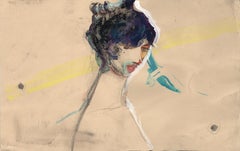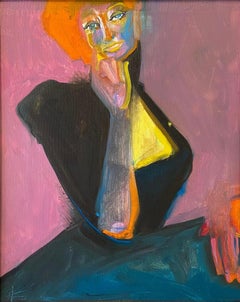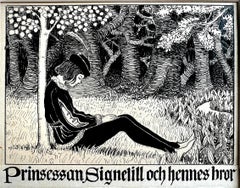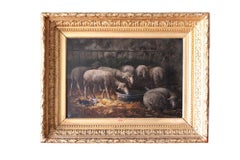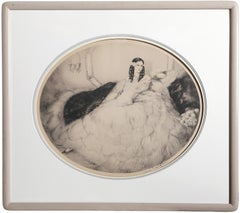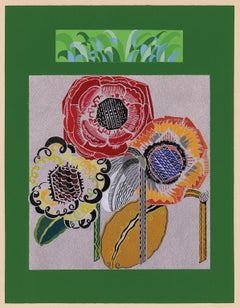Art Nouveau
to
157
728
214
154
82
176
Overall Width
to
Overall Height
to
1
554
702
97
202
97
100
72
8
9
14
10
11
17
116,674
65,330
53,618
26,865
14,615
9,446
6,043
5,781
4,159
3,014
2,546
2,271
2,234
719
928
245
18
926
649
328
304
280
188
188
176
163
123
121
87
68
67
52
48
47
45
43
42
692
215
195
144
105
104
35
35
30
30
256
215
625
624
Style: Art Nouveau
Seasons: Winter - Original lithograph (Catalog raisonne Bridges P3-6 PP21), 1896
Located in Paris, IDF
Alphonse Mucha
Seasons: Winter, 1896
Original lithograph
Printed signature in the plate
Printed on paper 108.5 x 57 cm (c. 42.5 x 22.4 inches)
On paper linen on canvas, 117 × 65.5 c...
Category
1890s Art Nouveau
Materials
Lithograph
Antique sheep oil painting animals in landscape signed portrait of sheep
Located in AIGNAN, FR
19th Century oil on canvas painting of sheep in a manger in it's original frame by French artist Hyacinthe Florentin Lepesqueu. This painting is signed in the bottom left corner. I...
Category
1870s Art Nouveau
Materials
Oil
Black Fan, Art Nouveau Aquatint Etching by Louis Icart
By Louis Icart
Located in Long Island City, NY
Louis Icart, French (1888 - 1950) - Black Fan, Year: 1931, Medium: Aquatint Etching, signed in pencil lower right, Image Size: 16 x 20.75 inches, Frame Size: 25.75 x 30 inches, P...
Category
1930s Art Nouveau
Materials
Etching, Aquatint
Paris Opera : Ballerina in the Stairs - Original lithograph 1897
By Henri Boutet
Located in Paris, IDF
Henri BOUTET (1851 - 1919)
Ballerina in the Stairs, 1897
Original lithograph (Champenois workshop)
Printed signature in the plate
On vellum, 40 x 31 cm (c. 16 x 12 in)
INFORMATION:...
Category
1890s Art Nouveau
Materials
Lithograph
'Poppy' — Art Deco Pochoir from the acclaimed portfolio 'RELAIS'
Located in Myrtle Beach, SC
Edouard Benedictus, 'Poppy' from the portfolio 'Relais', plate 14, color pochoir, 1930. Signed in the matrix, in the center bottom margin. A superb, richly-inked impression, with fresh, vibrant colors, including metallic gold and silver inks, on heavy, cream wove paper; the full sheet with margins (1 3/8 inches), in excellent condition. Published by Éditions Vincent, Fréal et Cie, Paris. The pochoir production is by Jean Saudé, the French printmaker known for his mastery of the technique and the author of the first how-to book on the pochoir process. Matted to museum standards, unframed.
Image size 14 3/8 x 11 inches (365 x 279 mm); sheet size 17 1/4 x 13 7/8 inches (438 x 352 mm).
Impressions of this work are held in the following museum collections: Cooper-Hewitt National Design Museum Library (Smithsonian), Metropolitan Museum of Art, Minneapolis Institute of Art, New York Public Library, Toledo Museum of Art, Victoria and Albert Museum (London), Virginia Museum of Fine Arts.
ABOUT THIS WORK
The Pochoir process is a refined stencil-based technique employed to create multiples or to add color to prints produced in other mediums. Characterized by its crisp lines and rich color, the print-making process was most popular from the late 19th century through the 1930s, with its center of activity in Paris. The pochoir process began with the analysis of an image’s composition, including color tones and densities. The numerous stencils (made of aluminum, copper, or zinc) necessary to create a complete image were then designed and hand-cut by the 'découpeur.' The 'coloristes' applied watercolor or gouache pigments through the stencils, skillfully employing a variety of different brushes and methods of paint application to achieve the desired depth of color and textural and tonal nuance. The pochoir process, by virtue of its handcrafted methodology, resulted in the finished work producing the effect of an original painting, and in fact, each print was unique.
ABOUT THE ARTIST
Edouard Benedictus (1878 -1930), artist, designer, composer, and chemist, was born and died in Paris. A highly-regarded designer and art critic of the Art Nouveau era, Benedictus gained renown as a colorist and creator of Art Deco-inspired geometric and floral motifs. His work had a significant influence on international fashions in clothing, home furnishings, graphic design, and decorative objects of the period, earning him commissions from leading European design firms. In 1925 he was invited to represent Art Deco textile design...
Category
1930s Art Nouveau
Materials
Stencil
Woman in the Poppies - Original lithograph, 1898
Located in Paris, IDF
Hans CHRISTIANSEN (1866 - 1945)
Woman in the Poppies, 1898
Original lithograph (Champenois workshop)
Printed signature in the plate
On vellum, 40 x 31 cm (c. 16 x 12 in)
INFORMATIO...
Category
1890s Art Nouveau
Materials
Lithograph
La Dame aux Camélias, Art Nouveau Aquatint Etching by Louis Icart
By Louis Icart
Located in Long Island City, NY
Louis Icart, French (1888 - 1950) - La Dame aux Camélias, Year: 1927, Medium: Aquatint Etching, signed in pencil lower right, Image Size: 16.5 x 20.5 inches, Frame Size: 25.5 x 2...
Category
1920s Art Nouveau
Materials
Etching, Aquatint
Seasons: Autumn - Original lithograph (Catalog raisonne Bridges P50), 1903
Located in Paris, IDF
Alphonse Mucha
Seasons: Autumn, 1903
Original lithograph
Printed signature in the plate
Printed on paper 71 x 31 cm (c. 27.9 x 12.2 inches)
On paper linen on canvas, 75 x 35.5 cm (c...
Category
Early 1900s Art Nouveau
Materials
Lithograph
"Les Septs Peches Captitaux" [The 7 Deadly Sins] Etchings, Pair
Located in Astoria, NY
Andre Lambert (French. 1884-1967), Two Prints from "Les Septs Peches Captitaux", Colored Etchings and Aquatints, one "La Paresse" [Sloth], signed in pencil lower right and numbered e...
Category
1910s Art Nouveau
Materials
Etching, Aquatint, Paper
Lillies, Art Nouveau Giclee Print after Louis Icart
By Louis Icart
Located in Long Island City, NY
Louis Icart, After, French (1888 - 1950) - Lillies, Year: 2000, Medium: Giclee on paper, numbered in pencil verso with printers stamp, Edition: 8/375, Size: 45 x 31 in. (114.3 x ...
Category
Early 2000s Art Nouveau
Materials
Giclée
The Birth of Venus - Original lithograph and watercolor
By Joseph Felon
Located in Paris, IDF
Joseph FELON (1818 - 1897)
The Birth of Venus
Original stone lithograph, enhanced with watercolor
Printed signature in the plate
On paper 33 x 50 cm (c. 12.9 x 19.6 inch)
Very good...
Category
Late 19th Century Art Nouveau
Materials
Lithograph, Watercolor
Orientalism : Young Women Playing - Original Lithograph, 1898
By Paul Leroy
Located in Paris, IDF
Paul LEROY
Orientalism : Young Women Playing, 1898
Original lithograph (Champenois workshop)
Printed signature in the plate
On vellum, 40 x 31 cm (c. 16 x 12 in)
INFORMATION: Litho...
Category
1890s Art Nouveau
Materials
Lithograph
Les Masques, Art Nouveau Color Etching by Louis Icart
By Louis Icart
Located in Long Island City, NY
Louis Icart, French (1888 - 1950) - Les Masques, Year: 1926, Medium: Color Etching, Signed in Pencil, Edition: 308, Size: 18.68 in. x 14.38 in. (47.43 cm x 36.51 cm), Frame Size:...
Category
1920s Art Nouveau
Materials
Etching
Mysterious Love - Original lithograph - 1898
Located in Paris, IDF
Henri Bellery-Desfontaines
Mysterious Love, 1898
Original lithograph (Champenois workshop)
Printed signature in the plate
On vellum, 40 x 31 cm (c. 16 x 12 in)
INFORMATION: Lithogr...
Category
1890s Art Nouveau
Materials
Lithograph
Huge French Arts & Crafts Painting Shepherd & Flock in Landscape, Ornate Frame
Located in Cirencester, Gloucestershire
French School, mid 20th century
indistinctly signed and dated lower right corner, inscribed into the paint.
oil painting on wood panel, presented within highly ornate carved wood or...
Category
Mid-20th Century Art Nouveau
Materials
Oil
Paresse, Art Nouveau Etching by Louis Icart
By Louis Icart
Located in Long Island City, NY
Louis Icart, French (1888 - 1950) - Paresse, Year: 1925, Medium: Etching, Image Size: 15 x 18.75 inches, Size: 23.5 in. x 27.5 in. (59.69 cm x 69.85 cm)
Category
1920s Art Nouveau
Materials
Etching
Original Quinquina Royal Est un vrai trésor vintage liquor poster c.1902
Located in Spokane, WA
Quinquina Royal Est un vrai trésor. Original Quinquina Royal antique French liquor poster. Artist: Eugene Oge. Size: 38.75" x 55". Archiv...
Category
Early 1900s Art Nouveau
Materials
Lithograph
$1,438 Sale Price
20% Off
Coleth : The Lovers of Venice Carnival - Original Art Deco pochoir
Located in Paris, IDF
Coleth
The Lovers of Venice Carnival
Original gouache and ink drawing (c. 1925)
Signed bottom right
On drawing paper 23 x 20 cm (c. 9 x 8 in) at view...
Category
Early 20th Century Art Nouveau
Materials
Gouache, Stencil
French antique bronze sculpture by Eutrope Bouret
Located in Berlin, DE
This is an outstanding bronze statue of Eutrope Bouret, signed on the base, by the very well-known French artist Eutrope Bouret (1833-1906).
French antique bronze sculpture by Eutro...
Category
19th Century Art Nouveau
Materials
Bronze
1900 original poster La Topaze by Alphonse Mucha, part of Les Pierres Précieuses
Located in PARIS, FR
The 1900 original poster "La Topaze" by Alphonse Mucha, part of the renowned "Les Pierres Précieuses" series, is a quintessential example of the Art Nouveau movement. This work, prin...
Category
Early 1900s Art Nouveau
Materials
Paper, Lithograph
French Revolution, the Battle of Valmy - Original Lithograph 1899
Located in Paris, IDF
Adolphe WILLETTE (1857-1926)
French Revolution, the Battle of Valmy, 1899
Original lithograph (Champenois workshop)
Printed signature in the plate
On ...
Category
1890s Art Nouveau
Materials
Lithograph
Antique French Art Nouveau Bronze Figure Statue Sculpture "Prise de Corsaire"
Located in Portland, OR
A fine antique large French Art Nouveau Bronze Figural Sculpture, titled "Prise de Corsaire" by Emmanuel Villanis (1858-1914), circa 1900.
This very...
Category
Early 1900s Art Nouveau
Materials
Bronze
Set of 2 French antique dog paintings 19th Century watercolour dog paintings
Located in AIGNAN, FR
An authentic pair of watercolours featuring hunting dogs in their original frames, untouched since the 1880's. Very delightful and expertly drawn. The first, larger painting is of ...
Category
1880s Art Nouveau
Materials
Watercolor
$378 Sale Price
39% Off
Original Paris 1900 de la Belle Epoque 1900-1914 vintage French movie poster
Located in Spokane, WA
Original 1947 Paris 1900 lithographic movie poster by the artist Raymond Peynet. The poster had originally been folded, and there is some wrinkling at the bottom edge of the poste...
Category
1940s Art Nouveau
Materials
Lithograph
CLÉMENT CYCLES Lithograph, Woman on Bicycle, Moon, French Advertising Art 52"
Located in Union City, NJ
CLÉMENT CYCLES is a fine art lithograph re-creation after the original French advertising poster created by PAL(Jean de Paleologue) for Fernand Clément Bicycle Co., France.
Hand craf...
Category
1990s Art Nouveau
Materials
Lithograph
Les Amants - Lithograph by Umberto Brunelleschi - 1930s
Located in Roma, IT
Les Amants is a color lithograph on ivory paper, realized by the Italian artist Umberto Brunelleschi (Montemurlo 1879- Paris 1949).
...
Category
1930s Art Nouveau
Materials
Lithograph
$177 Sale Price
25% Off
Brittany : Women in the Harbour - Original Lithograph, 1898
Located in Paris, IDF
Louis BORGEX
Brittany : Women in the Harbour , 1898
Original lithograph (Champenois workshop)
Printed signature in the plate
On vellum, 40 x 31 cm (c. 16 x 12 in)
INFORMATION: Lith...
Category
1890s Art Nouveau
Materials
Lithograph
Alphonse Mucha's 1902 Documents décoratifs - Planche 48
Located in PARIS, FR
Alphonse Mucha's name shines like that of a visionary artist who left an indelible mark on the aesthetics of the early 20th century. The year 1902 saw the publication of "Documents d...
Category
Early 1900s Art Nouveau
Materials
Lithograph, Paper
Imperia (Caprices of Verlaine) - Original Lithograph 1899
Located in Paris, IDF
Alfred Pierre AGACHE (1843-1915)
Imperia (Caprices of Verlaine), 1899
Original lithograph (Champenois workshop)
Printed signature in the plate
On vellum, 40 x 31 cm (c. 16 x 12 in)
...
Category
1890s Art Nouveau
Materials
Lithograph
1896 Original poster - Les Maîtres de l'affiche Pl. 2 - Divan Japonais
Located in PARIS, FR
Henri de Toulouse-Lautrec's "Divan Japonais, 75 rue des Martyrs" poster, created in 1896, is an emblematic example of the poster art of the period. It is part of the "Maîtres de l'Af...
Category
1890s Art Nouveau
Materials
Lithograph, Paper
Symbolism : Twilight - Original lithograph (1897/98)
Located in Paris, IDF
Paul Balluriau
Symbolism : Twilight, 1897
Original lithograph (Champenois workshop)
Printed signature in the plate
On vellum, 40 x 31 cm (c. 16 x 12 in)
INFORMATION: Lithograph cre...
Category
1890s Art Nouveau
Materials
Lithograph
Prochainement, Tournée du Chat Noir avec Rodolphe Salis; Black cat.
Located in La Canada Flintridge, CA
The poster was designed by Théophile Alexandre Steinlen in 1896 to promote the touring performances of the Le Chat Noir cabaret troupe led by Rodolphe Salis. It has since become one ...
Category
1990s Art Nouveau
Materials
Color
Portrait - Phototype after Paul César Helleu - Early-20th Century
Located in Roma, IT
Portrait is a phototype print realized by Paul Helleu in the Early-20th Century.
Good conditions .
The artwork is realized through deft expressive strokes.
Category
Early 20th Century Art Nouveau
Materials
Lithograph
Art Nouveau : Circus : Horsewoman - Original lithograph 1898
Located in Paris, IDF
Richard RANFT (1862 - 1931)
Art Nouveau : Circus : Horsewoman, 1898
Original lithograph (Champenois workshop)
Printed signature in the plate
On vellum, 40 x 31 cm (c. 16 x 12 in)
I...
Category
1890s Art Nouveau
Materials
Lithograph
1898 - Moulin Rouge Bal La Goulue - Les Maîtres de l'affiche Pl. 122
Located in PARIS, FR
A lithographic reproduction of Henri de Toulouse-Lautrec's "Moulin Rouge Bal La Goulue", created for Les Maîtres de l'Affiche as plate number 122, is an outstanding example of the po...
Category
1890s Art Nouveau
Materials
Lithograph, Paper
Beauty - Original lithograph - 1897
By Edward Burne-Jones
Located in Paris, IDF
Edward Burne-Jones
Beauty, 1898
Original lithograph (Champenois workshop)
Printed signature in the plate
On vellum, 40 x 31 cm (c. 16 x 12 in)
INFORMATION: Lithograph created for t...
Category
1890s Art Nouveau
Materials
Lithograph
Brittany - Original lithograph (1897-1898)
By Emile-Auguste Wery
Located in Paris, IDF
Emile-Auguste WERY (1868 - 1935)
Brittany, 1897
Original lithograph (Champenois workshop)
Printed signature in the plate
On vellum, 40 x 31 cm (c. 16 x 12 in)
INFORMATION: Lithogra...
Category
1890s Art Nouveau
Materials
Lithograph
La Monaca - Lithograph by Umberto Brunelleschi - 1930s
Located in Roma, IT
La Monaca is a color lithograph on ivory paper, created by the Italian artist Umberto Brunelleschi (Montemurlo 1879- Paris 1949).
Illustration for “Tales and Short Stories” by La Fo...
Category
1930s Art Nouveau
Materials
Lithograph
$195 Sale Price
25% Off
Torera: the Spanish Girl who could take on a bull latin art nouveau period oil
Located in Norwich, GB
My analysis of this striking art nouveau period painting evolved as I studied it. Initially, I thought it was simply a portrait of a dashing, stylish, somewhat androgynously dressed ...
Category
1890s Art Nouveau
Materials
Oil, Board
La Monaca - Lithograph by Umberto Brunelleschi - 1930s
Located in Roma, IT
La Monaca is a color lithograph on ivory paper, created by the Italian artist Umberto Brunelleschi (Montemurlo 1879- Paris 1949).
Illustration for “Tales and Short Stories” by La Fo...
Category
1930s Art Nouveau
Materials
Lithograph
PARERA Portrait Spanish elegant woman fan Belle Epoque 20th
Located in PARIS, FR
Francisco PARERA Y MUNTE 1850 - after 1920 Oil on canvas 72 x 52 cm (79 x 68 cm with the frame) Signed and dated lower right "F. Parera/ 1922" Beautiful antique oval frame
Francisco...
Category
1920s Art Nouveau
Materials
Oil
Carnaval.
Located in London, GB
BARBIER, George.
Carnaval.
London, C. W. Beaumont, 1913.
Barbier’s wonderful illustrations of the legendary dancer in Scheherazade, Carnaval and L’Après-midi d’un Faune
‘The d...
Category
1910s Art Nouveau
Materials
Lithograph
"Mediterranean Sunset: View from Corsica." Marcel Poggioli (French, 1882-1969)
Located in SANTA FE, NM
"Mediterranean Sunset: View from Corsica."
Marcel Poggioli (French, 1882-1969)
Oil on cardboard
16 x 9 3/4 (frame) inches
"Mediterranean Sunset: View from Corsica" exhibits a beau...
Category
1920s Art Nouveau
Materials
Oil, Cardboard
Nijinsky in Cleopatre.
Located in London, GB
BARBIER, George.
Nijinsky in Cleopatre.
London, C. W. Beaumont, 1913.
‘The designs, although somewhat fantastic in treatment, do convey the impression produced by Nijinsky in hi...
Category
1910s Art Nouveau
Materials
Lithograph
Oriental Woman (Femme du Riff) - original lithograph (1897-1898)
By Louis-Abel Girardot
Located in Paris, IDF
Louis Abel GIRARDOT (1848 - 1937)
Oriental Woman (Femme du Riff), 1897
Original lithograph
Printed signature in the plate
On vellum 40 x 31 cm (c. 16 x 12")
INFORMATION : Published...
Category
1890s Art Nouveau
Materials
Lithograph
"Art et Decoration" Original 1902 Art Nouveau Color Lithograph by Alphonse Mucha
Located in Chicago, IL
Plate 57 from "Documents Decoratifs", published by Librairie Centrale des Beaux-Arts in Paris, 1902.
Literature: Rennert/Weill, A.7 p. 389, Lendl p.132-33 no.105, Grand Palais no 28...
Category
1890s Art Nouveau
Materials
Lithograph
Nijinsky as 'the poet' in Les Sylphides.
Located in London, GB
BARBIER, George.
Nijinsky as 'the poet' in Les Sylphides.
London, C. W. Beaumont, 1913.
‘The designs, although somewhat fantastic in treatment, do convey the impression produced b...
Category
1910s Art Nouveau
Materials
Lithograph
Orientalist Painting "Constantine (Algeria) 1893" Claude Firmin-Goy (1864-1944)
Located in SANTA FE, NM
Constantine (Algeria) 1893”
Claude Firmin-Goy
Oil on canvas
11 3/4 x 15 1/2 (17 1/2 x 21 1/4 frame) inches
This bright and luminous work by the Avignon painter Claude Firmin-Goy re...
Category
1890s Art Nouveau
Materials
Canvas, Oil
French nudes painter - 20th century figure painting - Oil on canvas Paris
Located in Varmo, IT
French painter (early 20th century) - Female nude.
100 x 70 cm without frame, 109 x 79 cm with frame.
Antique oil painting on canvas, in a gilded wooden frame (some cracks).
Condi...
Category
1920s Art Nouveau
Materials
Canvas, Oil
$2,134 Sale Price
28% Off
Hydrangeas, Art Nouveau Color Etching by Louis Icart
By Louis Icart
Located in Long Island City, NY
Louis Icart, French (1888 - 1950) - Hydrangeas, Year: 1929, Medium: Color Etching, Signed in Pencil, Image Size: 16 x 20 inches, Frame Size: 24.5 x 28.5 inches, Reference: Figur...
Category
1920s Art Nouveau
Materials
Etching
Vaslav Nijinsky as Siegfried in Swan Lake.
Located in London, GB
BARBIER, George.
Vaslav Nijinsky as Siegfried in Swan Lake.
London, C. W. Beaumont, 1913.
‘The designs, although somewhat fantastic in treatment, do convey the impression produced...
Category
1910s Art Nouveau
Materials
Lithograph
Original Obligation et Action au Porteur illustrated by Alphonse Mucha
Located in PARIS, FR
The original "Obligation et Action au Porteur" illustrated by Alphonse Mucha represents a captivating blend of finance and artistry, showcasing Mucha's distinctive style and contribu...
Category
Early 20th Century Art Nouveau
Materials
Lithograph, Paper
Lefevre-Utile Lu Lu French cookie poster
Located in Spokane, WA
Lu Lu Bisquites; Lefevre -Utile ( Lefèvre-Utile) crackers. The original lithographic poster is printed in colors, and the vintage vintage poster is archival li...
Category
1910s Art Nouveau
Materials
Lithograph
$1,500 Sale Price
20% Off
Original Vichy stone lithograph vintage French poster
Located in Spokane, WA
Original vintage poster: Vichy travel poster. This is a stunning stone-lithographic turn-of-the-century poster. It advertises a train route to Vichy, France. The poster has been a...
Category
1890s Art Nouveau
Materials
Lithograph
Early 20th Century Society Portrait , Grand Duchess Charlotte of Luxembourg
Located in Cotignac, FR
Early 20th century oil on board society portrait by French artist Rose Teitgen-Obeurer. Signed top left.
A charming and characterful portrait of a fine lady...
Category
Early 20th Century Art Nouveau
Materials
Oil, Cardboard
Orientalist Painting “Tuareg Rider in the Desert, 1908” Paul Jouve (1878-1973)
By Paul Jouve
Located in SANTA FE, NM
“Tuareg Rider in the Desert, 1908”
Paul Jouve (1878-1973)
Oil on panel, signed lower right.
21 ¾ × 17 1/2 inches ( 27 ½ × 24 frame) inches
Paul Jouve’s work has been celebrated and ...
Category
Early 1900s Art Nouveau
Materials
Wood Panel, Oil
Double sided crayon drawing in colors: Study for "The Shoe" (recto)
Located in Fairlawn, OH
Double sided crayon drawing:
Front: Study for "The Shoe"
Reverse: Studies of Figures
Blue crayon, red and black crayons
Image size: 19.25 x 15.375 inches
Frame size: 30 x 25 1/2 inch...
Category
1890s Art Nouveau
Materials
Crayon
Alphonse Mucha's 1902 Documents décoratifs - Planche 45
Located in PARIS, FR
Alphonse Mucha's name shines like that of a visionary artist who left an indelible mark on the aesthetics of the early 20th century. The year 1902 saw the publication of "Documents d...
Category
Early 1900s Art Nouveau
Materials
Lithograph, Paper
Little Mule and white rabbit: 1890s novecento animal equestrian horse painting
Located in Norwich, GB
A gorgeous novecento animalier painting, depicting a curious colt and.a white rabbit, by Gaetano Jerace (1860-1940)
Gaetano Jerace was born in Polistena in Calabrian into a dynasty of artists: his brothers Francesco (1894-1937) and Vincenzo (1862-1947) also became painters.
Gaetano moved to Naples as a young man, where a attended the Academy of Fine Arts, studying with Francesco Lojacono...
Category
1890s Art Nouveau
Materials
Wood, Oil
Orignal Ville de Bruxelles City of Brussels vintage poster 1914
Located in Spokane, WA
Original Ville de Bruxelles (City of Brussels, Belgium) vintage art nouveau poster. This beautiful lithograph is in excellent condition, ...
Category
1910s Art Nouveau
Materials
Lithograph
Art Nouveau art for sale on 1stDibs.
Find a wide variety of authentic art Nouveau available for sale on 1stDibs. Works in this style were very popular during the 21st Century and Contemporary, but contemporary artists have continued to produce works inspired by this movement. If you’re looking to add art created in this style to introduce contrast in an otherwise neutral space in your home, the works available on 1stDibs include elements of yellow, orange, blue, green and other colors. Many Pop art paintings were created by popular artists on 1stDibs, including Alphonse Mucha, Jules Chéret, Henri de Toulouse-Lautrec, and Adolphe Willette. Frequently made by artists working with Lithograph, and Paper and other materials, all of these pieces for sale are unique and have attracted attention over the years. Not every interior allows for large Art Nouveau, so small editions measuring 1.58 inches across are also available. Prices for art made by famous or emerging artists can differ depending on medium, time period and other attributes. On 1stDibs, the price for these items starts at $1 and tops out at $198,500, while the average work sells for $1,683.

